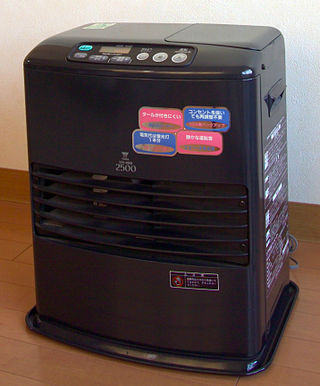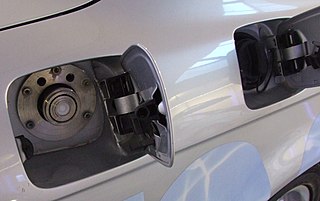

A blowtorch, also referred to as a blowlamp, is an ambient air fuel-burning gas lamp used for applying flame and heat to various applications, usually metalworking.


A blowtorch, also referred to as a blowlamp, is an ambient air fuel-burning gas lamp used for applying flame and heat to various applications, usually metalworking.
Early blowtorches used liquid fuel, carried in a refillable reservoir attached to the lamp. This is distinct from modern gas-fueled torches burning fuel such as a butane torch or a propane torch. Their fuel reservoir is disposable or refillable by exchange. Liquid-fueled torches are pressurized by a piston hand pump, while gas torches are self-pressurized by the fuel evaporation. The term "blowtorch" is commonly misused as a name for any metalworking torch, but properly describes the pressurized liquid fuel torches that predate the common use of pressurized fuel gas cylinders.
Torches are available in a vast range of size and output power. The term "blowtorch" applies to the obsolescent style of smaller liquid fuel torches. Blowtorches are typically a single hand-held unit, with their draught supplied by a natural draught of air and the liquid fuel pressurized initially by hand plunger pump, then by regenerative heating once the torch is in operating state. The larger torches may have a heavy fuel reservoir placed on the ground, connected by a hose. This is common for butane- or propane-fuelled gas torches, but also applies to the older, large liquid paraffin (kerosene) torches such as the Wells light.
Many torches now use a hose-supplied gas feed, which is often mains gas. They may also have a forced-air supply, from either an air blower or an oxygen cylinder. Both of these larger and more powerful designs are less commonly described as blowtorches, while the term blowtorch is usually reserved for the smaller and less powerful self-contained torches. The archaic term "blowpipe" is sometimes still used in relation to oxy-acetylene welding torches.
The blowtorch is of ancient origin and was used as a tool by goldsmiths and silversmiths. They began literally as a "blown lamp", a wick oil lamp with a mouth-blown tube alongside the flame. This type of lamp, with spirit fuel, continued to be in use for such small tasks into the late 20th century.
In 1797 or 1799, German inventor August von Marquardt invented a blowtorch in Eberswalde.
Another early blow pipe patent comes from the US, dated May 13, 1856.
In 1882, a new vaporizing technique was developed by Carl Richard Nyberg in Sweden, and the year after, the production of the Nyberg blowtorch started. It was quickly copied or licensed by many other manufacturers.
The US version of the blowtorch was independently developed with a distinctive flared base and was fueled by gasoline, whereas the European versions used kerosene for safety and low cost. [1]
After the Korean War in the 1950s, wider availability of propane caused many changes in the blowtorch industry worldwide, and by the 1970s most manufacturers of the old type of blowtorch, using gasoline or kerosene as fuel, had disappeared. [2] There remain several manufacturers producing brass blowtorches in India, China and North Korea for markets where propane gas is difficult to obtain or too expensive to be viable. [3]
The blowtorch is commonly used where a diffuse (wide spread) high temperature naked flame heat is required but not so hot as to cause combustion or welding. Temperature applications are soldering, brazing, softening paint for removal, melting roof tar, or pre-heating large castings before welding such as for repairing. It is also common for use in weed control by controlled burn methods, and for melting snow and ice from pavements and driveways in cold climate areas. Especially the US and Canada, road repair crews may use a blowtorch to heat asphalt or bitumen for repairing cracks in preventive maintenance. It is also used in cooking; one common use is for the creation of the layer of hard caramelized sugar in a crème brûlée. [4]
The blowtorch is referred to in industry and trade according to the fuel consumed by the tool:
In terms of gas torches, the fuel tank often is small and also serves as the handle. It is usually refueled by changing the fuel tank with the liquefied gas in it. The variants with gaseous fuel are sometimes fed from an LPG cylinder via a hose.
A flame gun is a large type of blowlamp with built-in fuel tank, used for various purposes: weed control by controlled burn methods, melting snow and ice off walk and driveways in the winter, starting a fire, etc. It is commonly confused in word usage with a flamethrower. [5]

A Bunsen burner, named after Robert Bunsen, is a kind of ambient air gas burner used as laboratory equipment; it produces a single open gas flame, and is used for heating, sterilization, and combustion.
Kerosene, or paraffin, is a combustible hydrocarbon liquid which is derived from petroleum. It is widely used as a fuel in aviation as well as households. Its name derives from Greek: κηρός (keros) meaning "wax", and was registered as a trademark by Canadian geologist and inventor Abraham Gesner in 1854 before evolving into a generic trademark. It is sometimes spelled kerosine in scientific and industrial usage.

Propane is a three-carbon alkane with the molecular formula C3H8. It is a gas at standard temperature and pressure, but compressible to a transportable liquid. A by-product of natural gas processing and petroleum refining, it is commonly used as a fuel in domestic and industrial applications and in low-emissions public transportation. Discovered in 1857 by the French chemist Marcellin Berthelot, it became commercially available in the US by 1911. Propane is one of a group of liquefied petroleum gases. The others include butane, propylene, butadiene, butylene, isobutylene, and mixtures thereof. Propane has lower volumetric energy density, but higher gravimetric energy density and burns more cleanly than gasoline and coal.

A kerosene lamp is a type of lighting device that uses kerosene as a fuel. Kerosene lamps have a wick or mantle as light source, protected by a glass chimney or globe; lamps may be used on a table, or hand-held lanterns may be used for portable lighting. Like oil lamps, they are useful for lighting without electricity, such as in regions without rural electrification, in electrified areas during power outages, at campsites, and on boats. There are three types of kerosene lamp: flat-wick, central-draft, and mantle lamp. Kerosene lanterns meant for portable use have a flat wick and are made in dead-flame, hot-blast, and cold-blast variants.

A portable stove is a cooking stove specially designed to be portable and lightweight, used in camping, picnicking, backpacking, or other use in remote locations where an easily transportable means of cooking or heating is needed. Portable stoves can be used in diverse situations, such as for outdoor food service and catering and in field hospitals.

Liquefied petroleum gas is a fuel gas which contains a flammable mixture of hydrocarbon gases, specifically propane, propylene, butylene, isobutane, and n-butane.

MAPP gas was a trademarked name, belonging to The Linde Group, a division of the former global chemical giant Union Carbide, for a fuel gas based on a stabilized mixture of methylacetylene (propyne), propadiene and propane. The name comes from the original chemical composition, methylacetylene-propadiene propane. "MAPP gas" is also widely used as a generic name for UN 1060 stabilised methylacetylene-propadiene.

Autogas or LPG is liquefied petroleum gas (LPG) used as a fuel in internal combustion engines in vehicles as well as in stationary applications such as generators. It is a mixture of propane and butane.

Industrial gases are the gaseous materials that are manufactured for use in industry. The principal gases provided are nitrogen, oxygen, carbon dioxide, argon, hydrogen, helium and acetylene, although many other gases and mixtures are also available in gas cylinders. The industry producing these gases is also known as industrial gas, which is seen as also encompassing the supply of equipment and technology to produce and use the gases. Their production is a part of the wider chemical Industry.

A flashback arrestor or flash arrestor is a gas safety device most commonly used in oxy-fuel welding and cutting to stop the flame or reverse flow of gas back up into the equipment or supply line. It protects the user and equipment from damage or explosions. These devices are mainly used in industrial processes where oxy-fuel gas mixtures are handled and used. Flashback arrestors as safety products are essential to secure the workplaces and working environment. In former times wet flashback arrestors were also used. Today the industry standard is to use dry flashback arrestors with at least two safety elements.

A kerosene heater, also known as a paraffin heater, is typically a portable, unvented, kerosene-fueled, space heating device. In Japan and other countries, they are a primary source of home heat. In the United States and Australia, they are a supplemental heat or a source of emergency heat during a power outage. Most kerosene heaters produce between 3.3 and 6.8 kilowatts.

Calor is a brand of bottled butane and propane which is available in Britain and Ireland. It comes in cylinders, which have a special gas regulator.

A propane torch is a tool normally used for the application of flame or heat which uses propane, a hydrocarbon gas, for its fuel and ambient air as its combustion medium. Propane is one of a group of by-products of the natural gas and petroleum industries known as liquefied petroleum gas (LPG). Propane and other fuel torches are most commonly used in the manufacturing, construction and metal-working industries.

A bivalent engine is an engine that can use two different types of fuel. Examples are petroleum/CNG and petroleum/LPG engines, which are widely available in the European passenger vehicle aftermarket.
Merox is an acronym for mercaptan oxidation. It is a proprietary catalytic chemical process developed by UOP used in oil refineries and natural gas processing plants to remove mercaptans from LPG, propane, butanes, light naphthas, kerosene and jet fuel by converting them to liquid hydrocarbon disulfides.

Oxy-fuel welding and oxy-fuel cutting are processes that use fuel gases and oxygen to weld or cut metals. French engineers Edmond Fouché and Charles Picard became the first to develop oxygen-acetylene welding in 1903. Pure oxygen, instead of air, is used to increase the flame temperature to allow localised melting of the workpiece material in a room environment. A common propane/air flame burns at about 2,250 K, a propane/oxygen flame burns at about 2,526 K, an oxyhydrogen flame burns at 3,073 K and an acetylene/oxygen flame burns at about 3,773 K.

A butane torch is a tool which creates an intensely hot flame using a fuel mixture of LPGs typically including some percentage of butane, a flammable gas.

Butane or n-butane is an alkane with the formula C4H10. Butane is a highly flammable, colorless, easily liquefied gas that quickly vaporizes at room temperature and pressure. The name butane comes from the root but- (from butyric acid, named after the Greek word for butter) and the suffix -ane. It was discovered in crude petroleum in 1864 by Edmund Ronalds, who was the first to describe its properties, and commercialized by Walter O. Snelling in early 1910s.

Carl Richard Nyberg was a Swedish inventor and industrialist. Nyberg was a pioneer in mechanical engineering. He received a patent for a blow lamp and was an aviation pioneer.

A fuel container is a container such as a steel can, bottle, drum, etc. for transporting, storing, and dispensing various fuels.